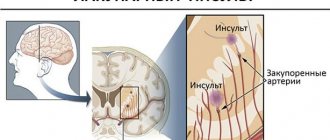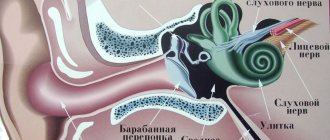Pain Treatment Center
Alekseeva
Oksana Alexandrovna
23 years of experience
Doctor, highest qualification category, member of the European Association of Neurologists, Russian Interregional Society for the Study of Pain (ROIB), Association of Interdisciplinary Medicine. Has experience working in hospital and outpatient services. He has seven published works on neurology.
Make an appointment
The term “neurosis” is usually used to designate a whole group of pathologies, which are based on temporary reversible mental disorders caused by excessive load on the basic nervous processes - excitation and inhibition. Neuroses are functional diseases that are not based on structural disorders. They arise as a result of a severe conflict within the individual or changes in particularly significant life relationships of a person and are manifested by exclusively mild neurotic symptoms and somato-vegetative deviations.
According to academician V.P. Pavlov, neurosis is a breakdown of higher nervous activity that occurs when the normal course of basic nervous processes, their relationships, strength and mobility changes. That is, this is a violation of higher nervous activity and neurovegetative functions, developing under the influence of mental trauma or prolonged emotional stress. It manifests itself primarily in the emotional sphere, while the state of affect provokes changes in thinking and general behavior.
This condition lasts from several days to several years. At the same time, the patient maintains a critical attitude towards the disease, there are no violations of social adaptation. People with melancholic and choleric types of temperament are more likely to suffer from neuroses, while sanguine and phlegmatic people suffer from them much less often.
A characteristic feature of all neuroses is the fact that a person is often aware of the meaninglessness of his symptoms (panic, fear, etc.) or the absence of grounds for somatic symptoms, but still feels anxiety associated with them. It is the patient's criticism of his symptoms that distinguishes neuroses from psychoses.
It should be noted that in the 10th edition of the International Classification of Diseases (ICD-10), the word “neurosis” is not used, and the dominant symptomatology became the basis for the classification of the corresponding group of mental diseases. Thus, some traditionally neurotic disorders belong to “eating disorders”, others to “sleep disorders of an inorganic nature”, etc.
But, despite the fact that the concept itself is gradually disappearing from the terminology of clinical diagnostics, it still remains widely used in psychological practice and the theoretical works of many authors. The concept of neurosis is still useful today when constructing a strategy for psychological support in the psychological service system.
The concept of neurosis unites a whole group of mental disorders with very different symptoms from all organs and systems. This includes a set of psychogenic, emotional and physiological disorders.
Symptoms and signs
Neuroses are characterized by dynamic and varied psychopathological and somatic symptoms against the background of insufficient mental defense. This is accompanied by the formation of a conflict, manifested by disturbances in different areas (emotional, vegetative, endocrine, etc.). There are main groups of clinical symptoms inherent in all types of neuroses, this includes disorders from:
1. self-control:
- discomfort;
- headache;
- feeling of weakness (especially after sleep);
- increased fatigue;
- decreased ability to work;
- prostration.
2. emotions:
- changeability (lability) of mood, irritability;
- tendency to depressive reactions, fears, obsessive concerns;
- violent affective outbursts followed by exhaustion;
- inadequacy of the emotional reaction to the strength of the stimulus;
- lack of control over emotions.
3. volitional sphere and drives:
- loss of appetite;
- sexual function;
- obsessive urges and actions;
- insufficient control of behavior.
4. somatovegetative system:
- hyperhidrosis (excessive sweating), hot flashes;
- increased dermographism (change in skin color, rash);
- tachycardia (rapid heartbeat), changes in blood pressure and pulse;
- constipation, nausea;
- frequent urination, enuresis;
- stuttering;
- tremor (shaking) of the body.
With each type of neurosis, especially its manifestation (vivid manifestation), an arbitrary number of the above symptoms may occur. In the process of further development of the disease, depending on personal characteristics, violations of mental or somatovegetative functions come to the fore.
The development of a certain type of disease significantly depends on the type of higher nervous activity (HNA). Individuals with an artistic type, in whom the first signaling system (subcortical processes) dominates the second (cerebral cortex), often experience hysterical neurosis. Individuals with the mental type GND are prone to obsessive-compulsive neuroses when the second signaling system prevails over the first. Most people have a mixed type of GND; most often they experience neurasthenia.
The essence of the problem
Situational neurosis includes a group of disorders of a different nature, provoked by a psychogenic situation, i.e., prolonged stress. The second name of the disease is psychasthenia. The clinic is characterized by predominant asthenic manifestations, a significant temporary or long-term decrease in physical activity. The course of the disease is reversible with timely assistance.
The essence of the problem lies in the disruption of the functionality of the higher nervous system. The mechanism of development is the action of psychogenic stimuli. A big role is given not even to the situation itself, but to its perception by a person and the adaptive characteristics of his body.
Under the influence of various factors, the following deviations may appear, provoked by disruption of the central nervous system:
- temporarily increased emotionality;
- neurotic syndrome;
- deep neurosis;
- a progressive form of psychosis.
The interaction of a traumatic situation and personal attitudes generates the main chain of neurosis. The further development of events, i.e., the resolution of a personal conflict and the successful overcoming of its consequences for the nervous system or the formation of a disorder with a violation of the personality structure, completely depends on the adaptive abilities of the body. Under the influence of stress, the central nervous system mobilizes all the forces of the body and throws them into the fight against the stimulus. This is revealed in the acceleration of metabolic processes and improved performance. If the body has successfully adapted to work without paying attention to the psychogenic situation, neurosis does not develop. With the inability to adapt, a violation of higher nervous activity occurs.
The problem of neurosis is the body’s inability to adapt to the current situation.
In any of its manifestations, the situational form of neurosis involves oxygen starvation of the brain, which leads to deformation of nerve cells. The sympathoadrenal system spasms, due to which the vessels narrow and the blood flow reduces its speed. In order to preserve the body, the nervous system redirects blood flow to vital systems. Due to the hormonal surge, tissues become more susceptible to the effects of catecholamines, which are produced by the body in large quantities. This causes symptoms such as nervousness and unreasonable fears.
Neurasthenia
It is characterized by the presence of diverse symptoms: somatic, neurological, psychopathological. Somatic symptoms are not associated with any disease of the internal organs, but are often so pronounced that they force the patient to constantly contact the appropriate doctors. Mainly observed manifestations of dysfunction of the cardiovascular system, tachycardia, sometimes slowing of the pulse, a feeling of pain, freezing or compression in the heart area. Sometimes there is dysfunction of the digestive tract: decreased or “crankiness” of appetite, nausea, upset stool. With neurasthenia, the symptoms of neurosis in women are expressed by abnormalities in the menstrual cycle. Neuroses in men are characterized by signs of impotence (various forms of impaired sexual desire and erection).
Common symptoms include hyperesthesia (increased sensitivity) to external stimuli (light, sound, etc.), poor health, which is difficult for patients to describe. There is a feeling of heaviness in the head (“cloudy head”), headache of undetermined localization, and dizziness. There are problems with sleep: falling asleep takes a long time, frequent awakenings, sleep is not deep enough, which means it does not bring pleasure and a feeling of rest, even if its duration is sufficient.
The neurological status shows increased tendon reflexes, tremor of extended limbs, severe sweating and other signs of irritation of the autonomic nervous system.
The psychopathological symptoms of neurasthenia are well described by the term “irritable weakness” - increased excitability is combined with rapid fatigue. A bad mood and emotional lability are inherent, which, unlike that in hysteria, is accompanied by rapid depletion of nervous processes. Emotional “explosions” begin easily, due to an insignificant reason. After them, the patient begins to repent of his behavior and feel awkward. Tearfulness is typical, even for neuroses in men, and imbalance when communicating with others. Working capacity, in particular mental, is reduced, but often a person, under the influence of tonic mental factors, can “pull himself together” and complete the required amount of work.
With neurasthenia there are no qualitative intellectual impairments. Patients complain of forgetfulness, poor memory in everyday life, and worry about this. Such manifestations are the consequences of impaired attention and poor concentration, but they pass without a trace.
There are two forms of neurasthenia: hypersthenic and hyposthenic. Hypersthenic is characterized by a predominance of symptoms of irritable weakness, and hyposthenic is characterized by asthenia of the nervous system (general weakness, lethargy, intolerance to any irritants and stress, decreased vitality).
Manifestation of situational neurosis
Some symptoms of this condition have already been given above. All possible manifestations can be divided into 2 large groups: mental and physical. Psychiatric manifestations include:
- anxiety;
- tension;
- nervousness;
- decreased concentration;
- pathological fixation on a traumatic situation;
- fears and negative expectations;
- memory impairment and others.
Mental manifestations reflect the fact that a person’s mental powers are diverted to maintaining balance, and they are not enough to support everyday mental activity. One of the main manifestations of situational neurosis can be described as mental fatigue. As it progresses, depression may develop, which is sometimes punctuated by exacerbations in the form of angry outbursts.
Outbursts of anger are one of the manifestations of situational neurosis
The physical manifestations of this neurotic disorder are quite varied. They arise due to a violation of the autonomic regulation of the internal organs. They may relate to cardiac activity, the gastrointestinal tract, and the genital area.
Often patients go to the doctor with precisely these complaints, without recognizing that their underlying cause is situational neurosis. Some of the symptoms: sweating, periodic palpitations, feeling of a lump in the throat, feeling of shortness of breath, tremors, dizziness, headaches.
Worth seeing: Intestinal neurosis
Obsessive-compulsive disorders (OCD)
They are demonstrated by a feeling of fearfulness, intimidation, and anxiety. Obsessive thoughts haunt the patient against his wishes and will, although they are assessed by him as meaningless and harmful. There are syndromes of the following obsessive states:
- doubts – uncertainty about the correctness of actions taken or not taken, contrary to logical arguments. Such a person doubts whether he turned off electrical appliances, closed the door, whether the document was written correctly, etc., although he has repeatedly checked the action performed;
- Memories are annoying pictures of the past. Often a sad, unpleasant or shameful incident for the patient, and he tries not to think about it;
- imagination - the emergence of implausible images, perceived as real despite their absurdity. There may be a belief that the buried relative was alive, or other similar misconceptions. In this case, the patient imagines and painfully experiences the suffering of the “obviously dead” person in the grave or other unpleasant feelings;
- drive - a desire to carry out some extremely undesirable action, accompanied by horror and panic due to the impossibility of freeing oneself from such a desire. For example, it covers the desire to harm a loved one, throw yourself under a train, a car, or push someone under it. At the same time, an unbearable fear is experienced that this is happening (contrasting attraction);
- phobias (fears) - an unreasonable fear of heights, open or confined spaces, crowds of people, sudden death, etc. Sometimes they are accompanied by rituals - monotonous actions that have the meaning of spells and amulets. Such actions are performed with the aim of protecting against a certain misfortune, despite the critical attitude towards them. So, by walking around the arch, instead of passing under it, a person seems to be saving his relatives from harm; when starting something, he snaps his fingers twice or says the “cherished” word out loud - in order to avoid failure.
Some obsessive actions fill the patient’s thoughts until they are implemented, others pass and are forgotten. To keep himself from becoming obsessed, he needs to constantly monitor himself, which is extremely tiring for him.
Close to obsessional neurosis in clinical terms are psychasthenia and psychasthenic neurosis. They are characterized by:
- predominance of asthenia (enduring fatigue, weakness);
- constant general feeling of tension with heavy foreboding;
- conviction of personal social inadequacy, ugliness and inferiority relative to others;
- excessive impressionability due to criticism addressed to oneself;
- reluctance to make contact without a guarantee of being liked;
- avoidance of social or professional activities associated with significant social contacts due to fear of criticism, disapproval, or ignorance;
- limited life and social way of life due to the need for physical and psychological safety.
Differential diagnosis is necessary to distinguish obsessional neurosis from schizophrenia, cerebral atherosclerosis, and the consequences of encephalitis. The distinctive feature of neurosis, and at the initial stage the only psychopathological symptom, will be obsession. There are no intellectual disorders. If the disease takes a long course and is not sufficiently treatable, it can affect the patient’s personality and his future fate.
Symptoms that characterize neurosis
Neurosis is distinguished from other pathologies of similar etiology according to the following characteristics:
- source of development – psychogenic factor;
- no dementia;
- personality changes do not increase;
- critical attitude towards oneself.
Characteristic symptoms of the disease include:
- cynicism;
- suppression of emotional background;
- fear and anxiety before something;
- indecisiveness and difficulties in communicating with people;
- underestimation or overestimation of self-esteem;
- phobias;
- panic;
- impossibility of determining life desires.
A person’s mood can change dramatically, as happens in pregnant women: positive emotions are abruptly replaced by irritability, aggression, and depression. The patient becomes vulnerable, touchy, and tearful. There is rapid fatigue, loss of memory and attention. There is an increase in sensitivity to loud sound and bright light.
The work and rest schedule is disrupted. A person is bothered by nighttime insomnia due to overexcitation during the day. This causes morning drowsiness and decreased performance.
With neurosis, headaches, heart pain, abdominal discomfort and nausea, signs of vegetative-vascular dystonia (dizziness, darkening of the eyes, etc.) often occur. The vestibular apparatus is disrupted: difficulties arise in coordinating movements. The attitude towards nutrition changes with the development of bulimia or, conversely, malnutrition.
There is increased sweating, changes in blood pressure, increased heart rate, cough, increased urge to urinate, and diarrhea.
In children
In childhood and preschool age, the symptoms are in many ways similar to the manifestations of pathology in an adult. The child's appetite decreases and sleep is disturbed due to nightmares. The temperature of the extremities decreases, and cold sweating increases.
The child suffers from headaches and is sensitive to bright lights and loud sounds. Behavior becomes unstable: positive emotions change to negative ones: crying, aggression, depression.
It is more difficult to cope and treat neurosis in childhood than the disease in adults. Due to the child’s brain not being fully formed, pathology can quickly progress and cause complete mental decomposition. In order to say goodbye to this disorder forever, it is important to contact a specialist as soon as possible at the first warning symptoms.
Hysterical neurosis
The clinical picture of hysteria is characterized by increased lability of emotions and the transition of the mental component to the somatoneurological one. This is the only form of neurosis when qualitative changes in consciousness are possible. Almost all symptoms of hysteria are protective for the patient, corresponding to a specific psychotraumatic situation. They bring a certain moral benefit to the individual, since they provide an opportunity to get rid of another difficult experience. Therefore, hysteria can be considered as a kind of protective phenomenon that occurs under the influence of a super-powerful stimulus.
Example: a mother received unexpected news about the tragic death of her son; while waiting for the body to be brought, she thought with horror that she would not be able to see him dead, and suddenly became blind; After a while, the hysterical blindness passed.
Emotional lability during hysteria manifests itself in a sharp change in emotions and their inconstancy. But, unlike neurasthenia, they are indicated by high intensity and duration. The patient, who a minute ago was crying bitterly and in deep despair, without much effort not only calms down, but also easily comes into a good mood. Such lability of emotions leads to instability in desires, intentions, behavior, likes and dislikes. In addition to emotional lability, a clear symptom of hysteria is easy suggestibility - both self-suggestion and the ability to be suggested by others.
The most striking reaction to a stimulus from the motor system will be a hysterical attack. Seizures do not occur when no one is near the patient, and are not accompanied by a sharp fall with bruises and injuries. Movement disorders have a pronounced neurotic character and coincide with the content of the patient’s experiences. He falls, chaotically swings his arms and legs, hits them on the floor, bends over, shouts out individual words. The seizure lasts from several minutes to hours. Unlike epileptic paroxysm, hysterical paroxysm is not accompanied by a clear violation of muscle tone, spasm of the sphincters with their relaxation and incontinence of urine and feces, the reaction of the pupils to light is preserved, and treatment is perceived adequately. After the attack, only a vague memory of it remains.
One type of hysteria is a disorder of consciousness under the influence of mental trauma. The perception of the surrounding reality is distorted. Behavior takes on childlike features, helplessness, and elements of fake dementia - pseudodementia. Some experience neurological symptoms: decreased sensitivity, trembling hands, hysterical deafness or muteness.
Significant strength and lability of emotions can sometimes cause a deviation of consciousness such as twilight stupefaction (hysterical delirium) and painful constriction (hysterical unconsciousness). The twilight state of hysteria usually demonstrates a pure type of painfully narrowed consciousness without stupor or other signs of its disturbance.
Stages of disease development
Neurotic reactions do not always turn into illness. It all depends on how long the person was in a stressful situation and how much he experienced it. Even if these reactions develop into a disease, it can end at any stage with appropriate treatment.
At the first stage, the body becomes weakened and the disease begins. At the second stage, the disorder of the nervous system already becomes acute, and at the third stage it becomes chronic. The fourth stage is the most difficult to treat, because at this stage neurotic reactions and behavior already become part of the person’s character.
In ICD-10, the second stage of situational neurosis is designated by code F43. The acute form of neurosis lasts several months or hours, it all depends on the amount of stress experienced by the person. This condition does not allow the nervous system to become exhausted and there is a huge danger that the patient will feel good in his status. Such patients begin to resist all types of treatment and subconsciously cling to the disease. Often people use their diagnosis to extract maximum bonuses for themselves from their family and friends. They can play on feelings of guilt, blame others for making him sick, or, on the contrary, appeal to pity, show how bad they feel and thereby receive additional attention from the family.
The disease at this stage can recede even without treatment, because if loved ones were the cause of stress and after the diagnosis changed their behavior, the stressful situation itself disappears and the person feels better!
By the way, often a diagnosis serves as an excellent excuse why something in life has not yet worked out or has not turned out the way I wanted, it’s so convenient - I’m sick, so I can’t work fully...
Whether the disease will recede or go into a chronic stage depends more on the mood of the patient, on what he is ready to do and whether he wants to get out of it. If, after all, the disease has passed into the third stage, chronic, a note is placed in ICD-10 when describing the disease with code F43.2.
The third stage - prolonged neurosis is characterized by the fact that even medication treatment does not help, and the patient’s disappointment in this treatment. This happens most often due to the fact that the stressful situation that caused the disease has not gone away. People can live in this state for years, the symptoms of the disease will either disappear almost completely or appear with renewed vigor. Patients are increasingly visited by thoughts that life has not gone well, that everything has failed and nothing good awaits them ahead.
People at this stage are already beginning to take the position of a loser to whom the world around them is simply unfair. And here comes a very dangerous line, because... the character gradually changes and neurotic reactions become its features. This is how a neurotic person adapts to his environment and has virtually no chance of healing!
Neurotic depression
Neurotic depression is typically characterized by a depressed state with some inhibition of psychomotor reactions and thinking. There are monotonous depressive memories, pessimistic views of the future, and fixation on the traumatic situation. There is a tendency to tearfulness, irritability, decreased appetite, sleep disturbance, sensitivity (excessive emotional sensitivity).
Neurotic depression does not reach the depth of psychosis, is reversible, and goes away when a traumatic situation is analyzed or under the influence of treatment.
What caused the reaction?
The specificity of the reaction is due to:
- characteristics of the state of health and nervous system;
- what aspects of existence are affected by unresolved conflict;
- degree of tension;
- the duration of existence of various factors and situations.
With prolonged tension, but not too strong, or when a person does not fully understand the causes of the conflict and does not act in any way to resolve it, the neurotic reaction is delayed. As a result, certain lasting changes occur in the psyche. They initially have the nature of an adaptation, but at the same time they can contribute to painful manifestations, creating a “vicious circle”. Under the influence of a neurotic disorder, a person’s character deteriorates, which is why his interaction with other people becomes more conflicting.
Causes
The main causes of neuroses are mental trauma and stress. They can be provoked by certain life circumstances, diseases, alcohol or drug use.
A neurotic breakdown is possible for any person, but its nature and form are determined by a whole group of factors. On the one hand, the formation of neurosis depends on the individual characteristics of the individual, hereditary selective tolerance to external influences, and the level of adaptive capabilities of the body. On the other hand, the occurrence of a particular neurosis is determined by the nature of the mental trauma. It can be sudden (death of a loved one) or arise as a result of long-term unfavorable conditions (conflict and tension in the family, at work).
But such situations do not always lead to neurosis. It all depends on how important it is to a person and how he feels about it. Favorable factors include mental trauma suffered in childhood, upbringing in a negative environment, and frequent somatic illnesses.
Causes of neuroses
Being a part of society, a person interacts with the environment that surrounds him, all the time colliding with the interests of others. Moreover, in the human psyche itself there may also be directly opposite aspirations, desires and attitudes. If, when there is a clash of interests, it is impossible to reach a compromise, then the situation, as they say, “hangs in the air” and creates internal tension.
Such tension may not be recognized at all, or it may be a certain background, which becomes aggravated upon contact with an irritating factor. Long-term tension robs a person of strength. As a result of the depletion of reserves inside, disruptions in the functioning of the nervous system begin.
The human nervous system, when under stress, loses stability and becomes exhausted. In response to a minimum of provoking factors or even without them, a not entirely normal mental reaction or painful symptom may appear, creating a clinical picture of a certain type of neurosis.
Diagnostics
In each specific case of a neurotic disorder, a varied pattern of symptoms of different types of neurosis may be demonstrated. All this can be accompanied by various symptoms of mental and somatic disorders, which creates certain difficulties in diagnosis. Therefore, the qualifications of the attending physician, his medical experience and professional skills are so important.
The collected anamnesis is of great importance - the patient’s complaints, his description of the nature and intensity of the symptoms, the time of their manifestation. It will also be important to talk with loved ones, since they can often provide valuable information. Medical observation in a hospital setting may be required to confirm or refute the diagnosis.
It is necessary to carefully check the level of hormones in the body, since the development and course of depression or neurosis are strongly influenced by hormones. This is especially true for thyroid hormones; even minor changes in their levels, which are difficult to detect using conventional tests, can have a very significant effect on well-being. If a hormonal imbalance is detected, proper hormonal therapy must be initiated. In some cases, normalization of thyroid function leads to a complete cure for neurosis.
Differentiated diagnosis is important when you need to be able to distinguish one pathology from another. Provided that neuroses are often accompanied by somatic symptoms, the doctor will prescribe an appropriate examination. In addition to general laboratory tests (blood, urine), specific studies (hormonal levels) may be required. If a brain disorder is suspected, magnetic resonance imaging (MRI) or computed tomography (CT) is recommended.
Psychological conflicts – causes of neuroses
The disorder most often arises on the basis of conflicts created in the mind, which are of two types:
- External . They are characterized by a discrepancy between the demands of the situation and the patient’s reaction to it.
- Internal . This is a struggle between logical conclusions and desires.
Situations that lead to neurotic conflict:
- In demand . The difficulty of making a decision when you need to settle on one of two desires of equal strength.
- Undesirables . The impact of negative emotions when it is necessary to choose any of the unfavorable directions.
- Ambiguous . Overload of consciousness, which has to find a suitable goal among ambiguous directions, where there are positive and negative qualities.
Some people have the ability to react to a difficult situation with a whole bunch of neuroses: weak people simply protect themselves from difficulties with neuroses. “Heart attacks” and pathological fears become the only way to get help from others.
The strength of mental trauma and symptoms depend not only on the situation, but also on the characteristics of the body: character, gender, age, upbringing, education, profession. ICD-10 recognizes this. Therefore, one person neutralizes the trauma, while the other remains inactive, which leads to neurotic conflicts.
Online appointment with a doctor in any city in Russia
Treatment
You need to know: all psychogenic disorders in neurosis are reversible, that is, they are completely curable! Since the main cause of pathology is internal conflicts in the human subconscious, the first priority for the successful treatment of neurosis will be to eliminate the traumatic situation, stress, or mitigate the reaction to them. Excluding the patient from traumatic circumstances (family troubles, conflict at work, etc.), they are analyzed. The next steps will be the use of treatment methods based on drug therapy and psychotherapy.
Treatment of situational neurosis
Eliminating the symptoms of the disease with medication is only possible temporarily. Treatment will be complete only if the conflict situation is eliminated or resolved. Drug therapy includes adaptogens, psychotropic drugs, and multivitamins. Physiotherapeutic treatment (massage, acupuncture) and restorative measures (physical therapy, swimming, normalization of the daily routine) also help.
The mainstay of treatment is psychotherapeutic influence. Sometimes you can resolve a conflict only by expanding your understanding of it and the role of its participants, and of your own capabilities. It’s not for nothing that there is a proverb: “If you can’t change a situation, change your attitude towards it.”
You can cure situational neurosis with the help of psychotherapeutic influence by changing your attitude towards the conflict
Various individual and group methods of self-development, auto-training, yoga, meditation and other practices help. An example is a practice called “Annulment of negative thought forms, fears, phobias, negative situations.” This technique is a combination of visualization, auto-training with elements of trance. When using any of the methods, the main thing is the person’s attitude to get rid of the problem, the willingness to make compromises in the search for solution options, and an understanding of the value of an adequate perception of the situation.
Drug therapy
The course of neurosis is associated with a simultaneous decrease in the level of brain serotonin, therefore long-term use of antidepressants - selective serotonin reuptake inhibitors - is prescribed for treatment. At the initial stage of treatment with antidepressants, their adverse reactions may occur, and the patient’s condition may worsen. In view of this, it is important not to stop taking the prescribed treatment, but only to reduce the dose of the drugs. Then, as tolerance improves, the dosage is gradually increased to the recommended values. Over time, the symptoms of neurosis decrease and the patient's condition improves.
Important: the antidepressant must be selected by a doctor! The selection takes into account the individual tolerability of the drug and its effectiveness for specific neurotic symptoms.
For the treatment of neuroses accompanied by insomnia or poor sleep, sedative and hypnotic antidepressants are prescribed. Sometimes, with great caution and in small doses, in short courses (to avoid addiction), tranquilizers are prescribed. When treating neuroses with concomitant weakness, memory loss, and asthenia, nootropic drugs are used. The duration of treatment is usually several months; if necessary, the course must be repeated.
How to prevent the development of pathology
It is impossible to say definitively that neurosis is incurable. It all depends on the characteristics of the human body and its desire to overcome pathology. Of course, rather than actively fighting the disease, it is better to direct all efforts to its prevention. If you listen to experienced doctors in this branch of medicine, this is not at all difficult to do. It is enough to follow some recommendations:
- Maintaining a healthy lifestyle. It is worth eliminating all bad habits, leading an active life, playing sports if possible, walking in the fresh air more often, and doing morning exercises.
- Avoid stressful situations and emotional overload.
- If necessary, short-term therapy with safe sedatives or antidepressants can be carried out (but only as prescribed by a doctor).
- Control and management of your emotional state, preventing the appearance of obsessive thoughts.
- Music therapy can be performed. This technique can act both as a preventative and as a therapeutic agent. Every day before going to bed, it is recommended to listen to calm music, ideally classical or folk music. Within a week, you can notice how your emotional state and sleep have normalized.
- Maintaining proper nutrition. The diet should be enriched with all useful vitamins and minerals.
The first symptoms of neurosis should not be overlooked. People who have become too aggressive, irritable and uncontrollable need emergency medical attention. Only timely initiation of therapy allows us to talk about a favorable prognosis and complete recovery.
Psychotherapy
In order to alleviate neurotic symptoms (by taking antidepressants), psychotherapy is carried out:
- Cognitive-behavioral therapy – formation in the patient of the correct reaction to the situation, strengthening his adequate assessment of his behavior in a traumatic situation, changing the way he responds to it;
- group psychotherapy – takes place for 1.5 hours daily or weekly, in the form of discussions. Topics are determined in advance; they relate to the biography, behavior of group members, and life situations. Group therapy has rules: strict confidentiality, sincerity of participants, experience “here and now,” specificity of topics. Groups can be closed - with a constant composition of participants, or open - someone comes, someone stops visiting;
- hypnotherapy - suggestion is carried out in a special state of the patient, hypnotic. The session includes 4 stages: hypnotization, therapeutic suggestion, therapeutic rest, dehypnotization;
- autogenic training;
- breathing exercises for relaxation and concentration;
- non-verbal methods of psychotherapy - music therapy, art therapy, dancing and pantomime.
The most effective treatment is a combination of antidepressant medication and cognitive behavioral therapy.
What doctors treat neuroses
Psychiatrists, psychotherapists and psychoneurologists play a leading role in the treatment of neuroses. Doctors of many specialties also take part in the treatment process: therapists, cardiologists, gastroenterologists, neurologists, etc.
Such a large list of specialists is explained by the need for accurate diagnosis while simultaneously excluding other pathologies. Quite often, neurosis is disguised as symptoms of neurocirculatory dystonia, insomnia (insomnia), migraine, vestibulopathy and many other diseases. To definitely confirm or refute a particular diagnosis, the participation of a specialized specialist is required.
Features of situational neurosis
If the conflict situation is clearly defined (the person knows what exactly unbalances him), and at the same time is quite strong in its impact, then situational neurosis may develop. A prerequisite for its occurrence is the absence for a person of a visible possibility of resolving the problem. This does not mean that there is no way out of the situation. It’s just that a person, being within the framework of his ideas, does not see this way out.
Worth seeing: Atarax: reviews from doctors for neurosis
The peculiarity of this neurosis is its clear connection to specific circumstances and its limited time. The patient indicates when his condition worsened and what caused it. Sometimes there is a painful fixation of attention on everything connected with this situation. A person exaggerates the meaning of certain facts. Also, sometimes there is a prejudiced attitude towards the participants in a protracted conflict and negative expectations.
Factors predisposing to the development of situational neurosis are some features of the human psyche: conflict, suspiciousness, pathological thoroughness, rigidity, as well as general social disadvantage. The role of external influence on a person is not absolute. The leading role in the development of this neurosis is not the circumstances, but the person’s reaction to them. Meanwhile, conflict resolution usually leads to the elimination of manifestations of the disorder.
One of the factors in the development of situational neurosis is general social disadvantage
Advantages of treatment at the clinic of JSC "Medicine"
The course of neurosis does not lead to disability, but often disrupts the full life of the patient and people close to him. In modern medicine, there are 3 stages of development of neuroses. The later the stage, the more difficult the treatment; this must be clearly understood. Medical specialists (academician Roitberg’s clinic) successfully treat neuroses in adults and children at any stage of complexity.
Remember: it is impossible to cure neurosis on your own, but in the conditions of the clinic of JSC “Medicine” it is absolutely possible to recover completely! Leading specialists of domestic medicine, including academicians, professors, doctors and candidates of medical sciences, conduct receptions here. Modern material and technical base, coupled with the professionalism of doctors, allows patients with neuroses to recover in the shortest possible time!
General principles of getting rid of pathology
How to treat neurosis yourself? You can enhance the basic treatment prescribed by your doctor by following some simple recommendations:
- There is no need to worry about every little thing. If you couldn’t avoid this, you shouldn’t accumulate negative emotions, it’s better to let them go. Heart-to-heart conversations with your closest relative or friend are perfect. If there are no interlocutors nearby, you can turn to a psychoanalyst. A specialist will conduct a psychotherapeutic session and help you relax.
- Periodically you need to relieve your emotional state. You can attend any interest groups: dancing, singing, yoga.
- Failure to comply with the work schedule can cause harm. If a person constantly works and does not rest as he should during the day, this negatively affects his psychological state. When engaged in mental activity, it is recommended to periodically switch to physical labor and vice versa.
- It is important to regulate sleep, which is allocated 6-8 hours a day. Before going to bed, you need to exclude any active stress (both physical and mental), ventilate your living space, and do not overeat.
- The diet should contain “anti-stress” foods that restore serotonin. These are fatty fish, tomatoes, bananas.
- There is no need to isolate yourself and stay at home all the time. It will be useful to visit a picnic with friends, a cafe or other places with large crowds of people.
However, you do not need to rely on treating neurosis only at home. Otherwise, complications can occur, including irreversible distortion of the psyche. Only a doctor can tell you what a person needs to do to restore mental activity.











